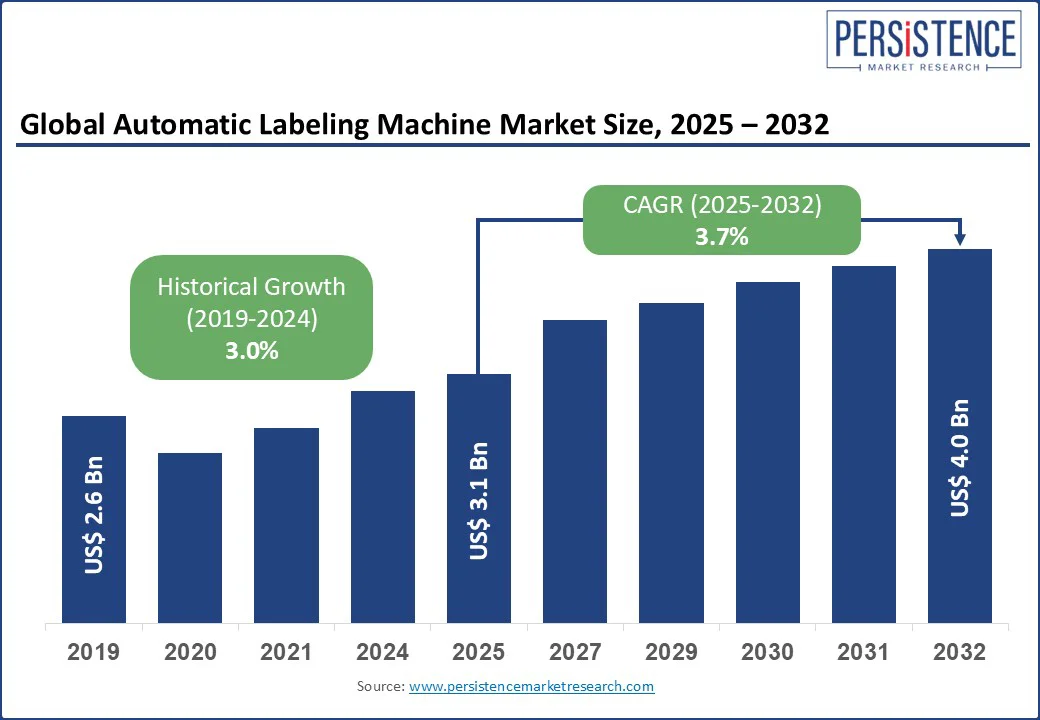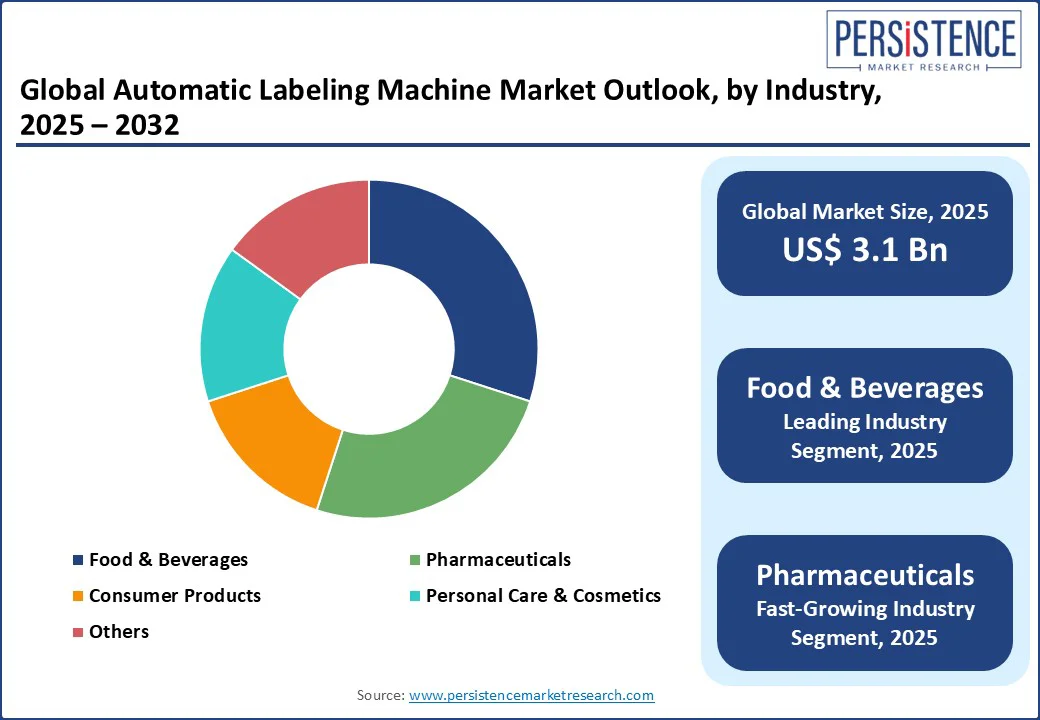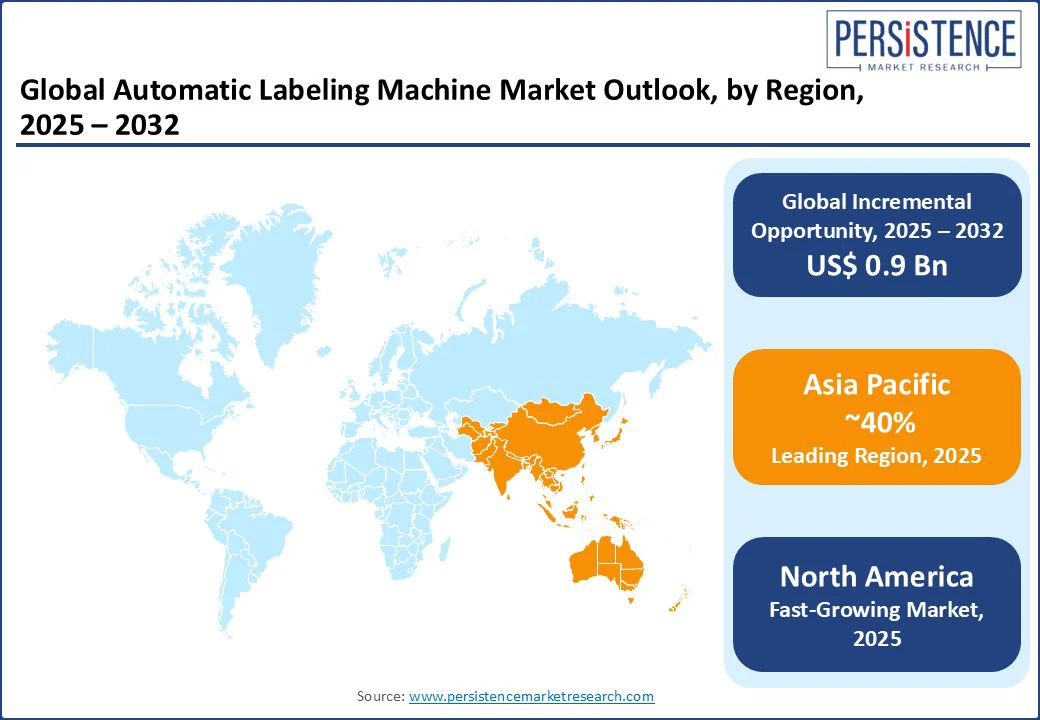ID: PMRREP29695| 198 Pages | 23 Aug 2025 | Format: PDF, Excel, PPT* | Packaging

The global automatic labeling machine market size is likely to be valued at US$3.1 Bn in 2025 and is projected to reach US$4.0 Bn by 2032, growing at a CAGR of 3.7% during the forecast period 2025 - 2032.
The automatic labeling machine industry is expected to experience significant growth in 2025, driven by rising demand for efficient and accurate labeling solutions across the food & beverages, pharmaceutical, cosmetics, and consumer goods sectors. Increasing emphasis on automation, regulatory compliance, and branding has fueled the adoption of fully automatic labeling systems.
Key Industry Highlights:

|
Global Market Attribute |
Key Insights |
|
Automatic Labeling Machine Market Size (2025E) |
US$3.1 Bn |
|
Market Value Forecast (2032F) |
US$4.0 Bn |
|
Projected Growth (CAGR 2025 to 2032) |
3.7% |
|
Historical Market Growth (CAGR 2019 to 2024) |
3.0% |
The automatic labeling machine market is driven by several key factors, with a significant focus on rising automation and stringent regulatory requirements in packaging, which in turn drive demand for labeling equipment and packaging labeler solutions. The global packaging automation market grew by 10% in 2025, increasing demand for bottle labeling machines, self-adhesive labeling systems, and industrial label applicators to enhance production efficiency.
A 2025 survey found that 70% of manufacturers prioritize the benefits of automatic labeling in manufacturing automation, resulting in a 15% reduction in labor costs. Pharmaceutical labeling compliance, driven by FDA and EU regulations, has boosted the adoption of barcode labeling systems by 20%, with 90% of pharmaceutical products expected to require compliant labels by 2025.
Food and beverage packaging, with a global market value of US$400 billion in 2025, supports automatic wrap-around labeling machines for bottles and adhesive labeling technology, with 50% of packaged foods utilizing pressure-sensitive labelers. Cosmetic product labeling, particularly for premium brands, increased by 12%, driven by advanced labeling equipment and fully integrated labeling systems for production lines, which ensure precision and scalability across various industries.
High initial costs and maintenance challenges pose significant restraints to the automatic labeling machine market, affecting the adoption of labeling equipment and industrial label applicators. The cost of fully automatic labeling machines, ranging from US$20,000 to US$100,000 per unit, deters small and medium enterprises, with 35% of SMEs opting for manual systems. Maintenance costs for barcode labeling systems and smart labeling equipment, which increase by 10% annually due to the complexity of their components, limit scalability.
Regulatory complexities, such as compliance with pharmaceutical labeling compliance standards, increase costs for self-adhesive labeling systems by 12%, Supply chain disruptions, with 15% cost hikes in raw materials such as adhesives in 2025, further challenge adhesive labeling technology adoption in price-sensitive markets such as Africa and parts of the Asia Pacific, constraining the growth of fully integrated labeling systems for production lines.
The rise of smart labeling equipment and expansion in emerging markets present significant opportunities for the automatic labeling machine market. The global smart packaging market is projected to grow at a CAGR of 8% through 2032, increasing demand for barcode labeling systems and pressure-sensitive labellers integrated with IoT and RFID technologies.
Online studies indicate that 20% of new labeling machines incorporate smart labeling equipment, boosting food and beverage packaging by 15%. Cosmetic product labeling, driven by 18% growth in premium skincare and beauty products, fuels demand for an automatic wrap-around labeling machine for bottles.
Companies such as Krones AG are investing US$150 Mn in R&D for fully integrated labeling systems for production lines, targeting pharmaceutical labeling compliance and personal care & cosmetics. Emerging markets, with 2 Bn new consumers by 2030, offer opportunities for industrial label applicators in food & beverages and consumer products, positioning adhesive labeling technology as a key growth driver.
Self-Adhesive/Pressure-Sensitive Labellers are expected to hold approximately 45% of the sector share in 2025, driven by their versatility in food and beverage packaging and pharmaceutical labeling compliance, with a 55% adoption rate in 2025. In the pharmaceutical sector, they play a critical role in meeting labeling standards for drug safety and traceability.
The need for cosmetic product labeling and automatic wrap-around labeling machines for bottles drives the demand for shrink-sleeve labellers. This growing preference for premium and visually appealing packaging is driving the adoption of shrink-sleeve technology, resulting in an estimated 15% market growth by 2025.
Fully Automatic labeling machines are expected to command a 50% market share in 2025, driven by the integration of labeling systems for production lines and barcode labeling systems, with a 60% adoption rate in 2025. These machines are extensively adopted in industries such as food & beverage, pharmaceuticals, and consumer goods, where automation and precision are critical. Their high operational efficiency reduces the need for manual intervention, improving throughput and minimizing errors.
Print & Apply Labeling Systems are fueled by smart labeling equipment and pharmaceutical labeling compliance. These systems are also used in logistics and packaging for variable data printing, including batch codes and expiration dates. The increasing focus on automation and regulatory requirements has fueled their uptake, resulting in a 12% market growth in 2025, as industries move toward flexible, on-demand labeling solutions.
Food & Beverages holds a 40% market share in 2025, driven by food and beverage packaging and bottle labeling machines, with 50% adoption in 2025, driven by the need for operational efficiency and attractive packaging designs. The increasing consumer preference for packaged foods, combined with the expansion of ready-to-drink beverages, has accelerated the adoption of these products.
Pharmaceuticals are driven by pharmaceutical labeling compliance and adhesive labeling technology, with a projected 15% growth in 2025. Serialization and barcode integration for anti-counterfeiting measures have further boosted the demand for advanced labeling systems. The growth of this sector is underpinned by the increasing production of generic drugs and vaccines, driving investments in precise and compliant labeling machinery.

In North America, the Automatic Labeling Machine Market holds a prominent position, commanding a 30% market share in 2025. The U.S. dominates due to its advanced manufacturing and packaging sectors, with $ 200 billion in packaged food sales in 2025. The U.S. market is driven by food and beverage packaging and pharmaceutical labeling compliance, with 70% of packaged goods expected to use a self-adhesive labeling system by 2025.
Cosmetic product labeling grew by 12%, with support from Procter & Gamble and L’Oréal. Smart labeling equipment sees 15% growth, aligning with automation trends. Krones AG and Quadrel Labeling Systems drive 25% of regional revenue, leveraging fully integrated labeling systems for production lines.
In Europe, the Automatic Labeling Machine Market accounts for a 35% market share, led by Germany, the UK, and France. Germany’s market is driven by food and beverage packaging and industrial label applicators, with 60% of packaged foods expected to use pressure-sensitive labelers in 2025. The UK’s pharmaceuticals sector is supported by barcode labeling systems adopted by GSK.
France’s personal care & cosmetics drives 12% growth in cosmetic product labeling. EU regulations promoting sustainable packaging boost 15% growth in adhesive labeling technology, with €100 Mn in funding for automation in 2025, enhancing smart labeling equipment. FUJI Seal International Inc. leads with 10% market share.
Asia Pacific is the most prominently growing region, with a CAGR of 4.2%, led by China, India, and Japan. China holds a 40% regional market share, driven by a 20% increase in packaged food consumption in 2025, boosting the demand for bottle labeling machines and food and beverage packaging.
India’s market is driven by pharmaceutical labeling compliance and a self-adhesive labeling system, with 85% of new drugs expected to utilize barcode labeling systems by 2025. Japan’s personal care & cosmetics drives 15% growth in cosmetic product labeling. World Pack Automation Systems Private Limited and Sato Holdings Corporation lead, supported by US$15 Bn in packaging automation investments by 2030.

The global automatic labeling machine market is highly competitive, with packaging equipment manufacturers competing on innovation, precision, and sustainability. Krones AG and FUJI Seal International Inc. dominate in fully automatic labeling machines, while Quadrel Labeling Systems leads in barcode labeling systems.
Pressure-sensitive labellers, smart labeling equipment, and cosmetic product labeling add a competitive layer. Strategic partnerships and R&D investments in the benefits of automatic labeling in manufacturing automation are key differentiators.
The automatic labelling machine market is projected to reach US$ 3.1 Bn in 2025, driven by bottle labelling machine and food and beverage packaging.
Automation, pharmaceutical labelling compliance, and fully integrated labelling systems for production lines are key drivers.
The automatic labelling machine market grows at a CAGR of 3.7% from 2025 to 2032, reaching US$ 4.0 Bn by 2032.
Opportunities include smart labelling equipment, cosmetic product labeling, and barcode labelling systems.
Key players include Krones AG, FUJI Seal International Inc., Quadrel Labelling Systems, HERMA Labelling Machines, and Sato Holdings Corporation.
|
Report Attribute |
Details |
|
Historical Data/Actuals |
2019 - 2024 |
|
Forecast Period |
2025 - 2032 |
|
Market Analysis Units |
Value: US$ Bn, Volume: As Applicable |
|
Geographical Coverage |
|
|
Segmental Coverage |
|
|
Competitive Analysis |
|
|
Report Highlights |
|
|
Customization and Pricing |
Available upon request |
By Product Type
By Technology
By Industry
By Region
Delivery Timelines
For more information on this report and its delivery timelines please get in touch with our sales team.
About Author